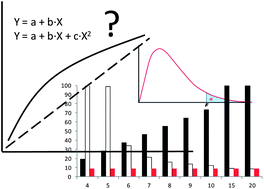
Mandel's test for goodness of fit
The economic and time constraints that limit the collection of calibration data mean that analytical chemists rely on robust statistical tests for linearity to support the accuracy of their findings. Mandel’s test was first proposed in 1964 and despite being simplified and suggested by IUPAC in 1998, has not been used broadly. Recently the Mandel’s test enjoyed an increase in popularity, possibly because non-linear data points are now more straightforward to plot using spreadsheets (linear model).
In this Analytical Methods paper, José M. Andrade and María P. Gómez-Carracedo at the University of A Coruna examined the validity of the definition of the test provided by IUPAC. They compared this approach to Mandel’s original definition, presenting ten different scenarios from simulated data. These simulations vary by number of data points and magnitude of the variances of the linear (IUPAC) or non-linear (Mandel’s) models. Surprisingly, the authors concluded that the 1998 IUPAC interpretation of this test does not strictly adhere to the definition published by Mandel, and is only valid within certain key limitations. The authors provide useful recommendations to analytical chemists intending to use Mandel’s test in their calibration calculations.
Notes on the use of Mandel’s test to check for nonlinearity in laboratory calibrations
J. M. Andrade and M. P. Gómez-Carracedo
Anal. Methods, 2013, Advance Article
DOI: 10.1039/C2AY26400E










